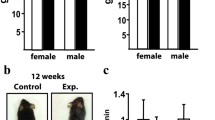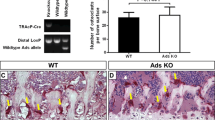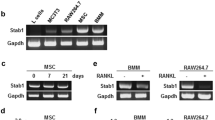Abstract
Calcium is a key component of the bone mineral hydroxyapatite. During osteoclast-mediated bone resorption, hydroxyapatite is dissolved and significant quantities of calcium are released. Several calcium transport systems have previously been identified in osteoclasts, including members of the sodium/calcium exchanger (NCX) family. Expression pattern and physiological role of NCX isoforms in osteoclasts, however, remain largely unknown at the moment. Our data indicate that all three NCX isoforms (NCX1, NCX2, and NCX3) are present in murine osteoclasts. RANKL-induced differentiation of murine osteoclast precursors into mature osteoclasts significantly attenuated the expression of NCX1, while NCX2 and NCX3 expressions were largely unaffected. To study the role of NCX1 during osteoclast differentiation and bone resorption, we crossed mice with exon 11 of the NCX1 gene flanked by loxP sites with cathepsin K-Cre transgenic mice. Mature osteoclasts derived from transgenic mice exhibited an 80–90% reduction of NCX1 protein. In vitro studies indicate that NCX1 is dispensable for osteoclast differentiation, but NCX1-deficient osteoclasts exhibited increased resorptive activity. In line with these in vitro findings, mice with an osteoclast-targeted deletion of the NCX1 gene locus displayed an age-dependent loss of bone mass. Thus, in summary, our data reveal NCX1 as a regulator of osteoclast-mediated bone resorption.







Similar content being viewed by others
References
Albano G, Moor M, Dolder S, Siegrist M, Wagner CA, Biber J, Hernando N, Hofstetter W, Bonny O, Fuster DG (2015) Sodium-dependent phosphate transporters in osteoclast differentiation and function. PLoS One 10:e0125104
Amran MS, Homma N, Hashimoto K (2003) Pharmacology of KB-R7943: a Na+-Ca2+ exchange inhibitor. Cardiovasc Drug Rev 21:255–276
Berger CE, Rathod H, Gillespie JI, Horrocks BR, Datta HK (2001) Scanning electrochemical microscopy at the surface of bone-resorbing osteoclasts: evidence for steady-state disposal and intracellular functional compartmentalization of calcium. J Bone Miner Res 16:2092–2102
Datta HK, Horrocks BR (2003) Mechanisms of calcium disposal from osteoclastic resorption hemivacuole. J Endocrinol 176:1–5
Egermann M, Heil P, Tami A, Ito K, Janicki P, Von Rechenberg B, Hofstetter W, Richards PJ (2009) Influence of defective bone marrow osteogenesis on fracture repair in an experimental model of senile osteoporosis. J Orthop Res.
Fuster DG, Zhang J, Shi M, Bobulescu IA, Andersson S, Moe OW (2008) Characterization of the sodium/hydrogen exchanger NHA2. J Am Soc Nephrol 19:1547–1556
Henderson SA, Goldhaber JI, So JM, Han T, Motter C, Ngo A, Chantawansri C, Ritter MR, Friedlander M, Nicoll DA, Frank JS, Jordan MC, Roos KP, Ross RS, Philipson KD (2004) Functional adult myocardium in the absence of Na+-Ca2+ exchange: cardiac-specific knockout of NCX1. Circ Res 95:604–611
Hofstetter W, Siegrist M, Simonin A, Bonny O, Fuster DG (2010) Sodium/hydrogen exchanger NHA2 in osteoclasts: subcellular localization and role in vitro and in vivo. Bone 47:331–340
Iwamoto T, Kita S, Uehara A, Imanaga I, Matsuda T, Baba A, Katsuragi T (2004) Molecular determinants of Na+/Ca2+ exchange (NCX1) inhibition by SEA0400. J Biol Chem 279:7544–7553
Khananshvili D (2014) Sodium-calcium exchangers (NCX): molecular hallmarks underlying the tissue-specific and systemic functions. Pflügers Archiv European Journal of Physiology 466:43–60
Kim HJ, Prasad V, Hyung SW, Lee ZH, Lee SW, Bhargava A, Pearce D, Lee Y, Kim HH (2012) Plasma membrane calcium ATPase regulates bone mass by fine-tuning osteoclast differentiation and survival. J Cell Biol 199:1145–1158
Li JP, Kajiya H, Okamoto F, Nakao A, Iwamoto T, Okabe K (2007) Three Na+/Ca2+ exchanger (NCX) variants are expressed in mouse osteoclasts and mediate calcium transport during bone resorption. Endocrinology 148:2116–2125
Moonga BS, Davidson R, Sun L, Adebanjo OA, Moser J, Abedin M, Zaidi N, Huang CL, Zaidi M (2001) Identification and characterization of a sodium/calcium exchanger, NCX-1, in osteoclasts and its role in bone resorption. Biochem Biophys Res Commun 283:770–775
Moonga BS, Li S, Iqbal J, Davidson R, Shankar VS, Bevis PJ, Inzerillo A, Abe E, Huang CL, Zaidi M (2002) Ca(2+) influx through the osteoclastic plasma membrane ryanodine receptor. Am J Physiol Renal Physiol 282:F921–F932
Nakamura T, Imai Y, Matsumoto T, Sato S, Takeuchi K, Igarashi K, Harada Y, Azuma Y, Krust A, Yamamoto Y, Nishina H, Takeda S, Takayanagi H, Metzger D, Kanno J, Takaoka K, Martin TJ, Chambon P, Kato S (2007) Estrogen prevents bone loss via estrogen receptor alpha and induction of Fas ligand in osteoclasts. Cell 130:811–823
Nesbitt SA, Horton MA (1997) Trafficking of matrix collagens through bone-resorbing osteoclasts. Science 276:266–269
Nowycky MC, Thomas AP (2002) Intracellular calcium signaling. J Cell Sci 115:3715–3716
Salo J, Lehenkari P, Mulari M, Metsikko K, Vaananen HK (1997) Removal of osteoclast bone resorption products by transcytosis. Science 276:270–273
Silver IA, Murrills RJ, Etherington DJ (1988) Microelectrode studies on the acid microenvironment beneath adherent macrophages and osteoclasts. Exp Cell Res 175:266–276
Takayanagi H, Kim S, Koga T, Nishina H, Isshiki M, Yoshida H, Saiura A, Isobe M, Yokochi T, Inoue J, Wagner EF, Mak TW, Kodama T, Taniguchi T (2002) Induction and activation of the transcription factor NFATc1 (NFAT2) integrate RANKL signaling in terminal differentiation of osteoclasts. Dev Cell 3:889–901
Teti A, Grano M, Colucci S, Argentino L, Barattolo R, Miyauchi A, Teitelbaum SL, Hruska KA, Zambonin Zallone A (1989) Voltage dependent calcium channel expression in isolated osteoclasts. Boll Soc Ital Biol Sper 65:1115–1118
van der Eerden BC, Hoenderop JG, de Vries TJ, Schoenmaker T, Buurman CJ, Uitterlinden AG, Pols HA, Bindels RJ, van Leeuwen JP (2005) The epithelial Ca2+ channel TRPV5 is essential for proper osteoclastic bone resorption. Proc Natl Acad Sci U S A 102:17507–17512
Wiltink A, Nijweide PJ, Scheenen WJ, Ypey DL, Van Duijn B (1995) Cell membrane stretch in osteoclasts triggers a self-reinforcing Ca2+ entry pathway. Pflugers Arch 429:663–671
Xie W, Lorenz S, Dolder S, Hofstetter W (2016) Extracellular iron is a modulator of the differentiation of osteoclast lineage cells. Calcif Tissue Int 98:275–283
Acknowledgements
We thank Kenneth Philippson, Department of Physiology, David Geffen School of Medicine, UCLA for NCX1 mutant mice. DGF was supported by the Swiss National Science Foundation (grant nos. 3100A0_135503 and 3100A0_152829) and by a Medical Research Position Award of the Foundation Prof. Dr. Max Cloëtta. OB is supported by a Swiss National Science Foundation professorship grant (PP00P3-133648). This work was further supported by the Swiss National Science Foundation funded National Centers for Competence in Research (NCCR Transcure and NCCR Kidney.CH) to DGF, OB, and WH.
Author information
Authors and Affiliations
Corresponding author
Ethics declarations
All animal experiments were in accordance with the Swiss Animal Welfare Law and were approved by the Local Veterinary Authority Bern (Veterinäramt Bern) and Vaud (Office vétérinaire cantonal).
Conflict of interest
The authors declare that they have no conflict of interest.
Additional information
Olivier Bonny and Daniel G. Fuster contributed equally.
Electronic supplementary material
.
ESM 1
(DOCX 155 kb)
Rights and permissions
About this article
Cite this article
Albano, G., Dolder, S., Siegrist, M. et al. Increased bone resorption by osteoclast-specific deletion of the sodium/calcium exchanger isoform 1 (NCX1). Pflugers Arch - Eur J Physiol 469, 225–233 (2017). https://doi.org/10.1007/s00424-016-1923-5
Received:
Revised:
Accepted:
Published:
Issue Date:
DOI: https://doi.org/10.1007/s00424-016-1923-5




